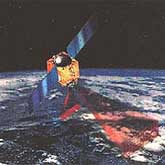NASA Headquarters

Science Facts Written by NASA Headquarters
Will Runaway Water Warm the World?
Water in the upper atmosphere will make the Earth heat up, but not as much as many scientists have believed, says a new study published by NASA scientists. Using satellite data, researchers Ken ... Continue reading

NASA Hits a Hole-In-One
How are NASA and golf related? Ask the professional golfers using clubs made from NASA's space-age technology. NASA needed stronger, more durable materials for its space missions. A landmark discovery ... Continue reading
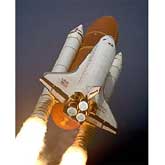
Retreating Glaciers Spur Alaskan Earthquakes
Could an extra warm summer cause an earthquake in your backyard? Probably not... unless you live in Alaska. You probably know that friction in the earth's crust causes earthquakes, but did you know ... Continue reading
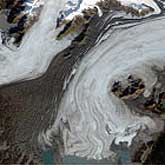
Wetter not Necessarily Better in Amazon Basin
June through September is the dry season for the Amazon Basin of South America. Yet the basin's dry season may be getting uncharacteristically wetter, according to NASA's Goddard Space Flight Center ... Continue reading

Blast Wave Blows Through the Solar System
Although the Sun provides the means for life on Earth, it has a dark side - the Sun regularly sends massive solar explosions of radiative plasma with the intensity of a billion megaton bombs hurtling ... Continue reading
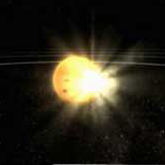
Mercury
The small and rocky planet Mercury is the closest planet to the Sun; it speeds around the Sun in a wildly elliptical (non-circular) orbit that takes it as close as 47 million km and as far as 70 ... Continue reading

The Sun’s Corona
The White-Light Corona - The Corona is the Sun's outer atmosphere. It is visible during total eclipses of the Sun as a pearly white crown surrounding the Sun. The corona displays a variety of features ... Continue reading
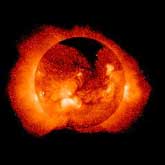
Live Fast, Blow Hard, and Die Young
Massive stars lead short, yet spectacular lives. And, they usually do not go quietly, instead often blowing themselves apart in supernova explosions. Astronomers are curious about the details of the ... Continue reading
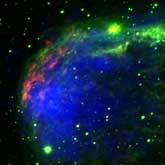
It's Dusty Out There
There is no lower limit to the size of the solid particles that move around the Sun. Small asteroids grade downward into large meteoroids and then into smaller pebbles and so on down to the tiniest ... Continue reading

Light Fantastic
On the next hot summer day, imagine what would happen if the Sun suddenly became one million times brighter. Ice cream would quickly melt, sunscreen lotion wouldn't work very well, and that's just the ... Continue reading
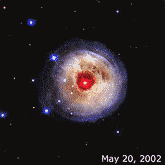
New Evidence Points to a Gamma-Ray Burst... In Our Own Backyard
Only 35,000 light years away lies W49B, the supernova remnant left over from the cataclysmic burst. New evidence pointing to a gamma ray burst origin for this remnant was discovered by X-ray data from ... Continue reading
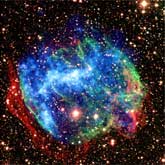
A Map of the Sky
Niagara Falls, the Grand Canyon, Old Faithful... we know they're spectacular sites, but how did we find out about them? Early explorers took the time to map out the United States and as a result, you ... Continue reading
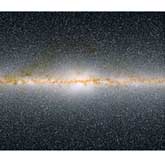
Hats Off to the Sombrero
This nearly edge-on view of the Sombrero galaxy shows that the disks of spiral galaxies are incredibly thin. The majestic spiral arms cannot be seen in this side view of the Sombrero, named because it ... Continue reading
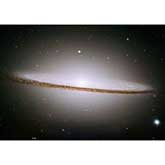
Nursery of Giants Captured in New Spitzer Image
Typically, the bigger something is the easier it is to find. Elephants, for example, are not hard to spot. But when it comes to the massive stars making up the stellar nursery called DR21, size does ... Continue reading

Hubble & Keck Teams Find Farthest Known Galaxy in Universe
An international team of astronomers may have set a new record in discovering what is the most distant known galaxy in the universe. Located an estimated 13 billion light-years away, the object is ... Continue reading
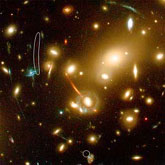
The Sun, The Mighty Engine Of Our Solar System
Our Sun has inspired mythology in almost all cultures, including ancient Egyptians, Aztecs, Native Americans, and Chinese. We now know that the Sun is a huge, bright sphere of mostly ionized gas, ... Continue reading
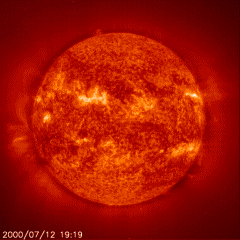
A Satellite Of Our Own
The regular daily and monthly rhythms of Earth's only natural satellite, the Moon, have guided timekeepers for thousands of years. Its influence on Earth's cycles, notably tides, has also been charted ... Continue reading
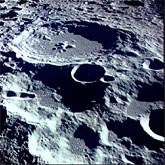
The Good, the Bad and the Ozone
Ozone is a big buzz word these days. We mostly hear about the ozone layer, and the importance of protecting it. But if you want to understand what ozone's all about, you need to understand that it can ... Continue reading
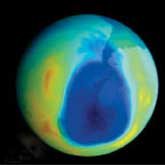
Cosmos Provides Astronomers with Planet-Hunting Tool
If only astronomers had a giant magnifying glass in space, they might be able to uncover planets around other stars. Now they do -- sort of. Instead of magnifying a planet, astronomers used the ... Continue reading

Large Asteroid Zooms Safely Past Earth
A mountain-sized asteroid made its closest approach to Earth at 9:35 a.m. Eastern Time on Wednesday, Sept. 29, 2004. Although asteroid 4179 Toutatis came no closer than four times the distance between ... Continue reading
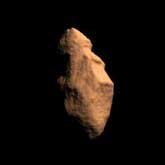
Amazing GRACE
Gravity has an effect on everyone and everything on Earth. Although we can't see it, smell it, taste it or touch it, we know it's there. Although scientists already know quite a bit about this ... Continue reading
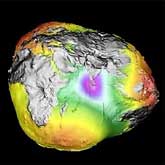
Introduction To Jupiter
With its numerous moons and several rings, the Jupiter system is a 'mini-solar system.' Jupiter is the most massive planet in our solar system, and in composition it resembles a small star. In fact, ... Continue reading
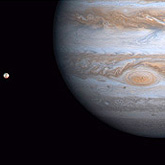
Non-Flammable Fuel?
When we're flying high above the Earth, few of us give much thought to aircraft safety. We're usually too busy wondering when lunch is going to be served. But flying safely is a goal of NASA's Glenn ... Continue reading

The Kuiper Belt
The Kuiper (pronounced Ki-Per) Belt is often called our solar system's 'final frontier.' This disk-shaped region of icy debris is about 12 to 15 billion kilometers (2.8 billion to 9.3 billion miles) ... Continue reading

Dark Energy Changes the Universe
Dark energy has the cosmoslogists scratching their heads. Observations taken by NASA's Hubble Space Telescope and future space telescopes will be needed in order to determine the properties of dark ... Continue reading
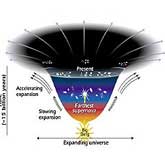
NASA's First Historic Challenge
In a time of uncertainty at home and abroad, an American president proposes bold new steps in the exploration of space. He calls for 'longer strides' which 'may hold the key to our future here on ... Continue reading

NASA Spacecraft Reveals Surprising Anatomy Of A Comet
Findings from a historic encounter between NASA's Stardust spacecraft and a comet have revealed a much stranger world than previously believed. The comet's rigid surface, dotted with towering ... Continue reading

Stars With Long Hair
Throughout history, people have been both awed and alarmed by comets, stars with 'long hair' that appeared in the sky unannounced and unpredictably. We now know that comets are dirty-ice leftovers ... Continue reading
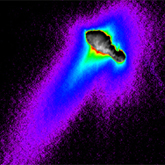
GP-B: More Than Just a Pretty Face
Questions about the ways space, time, light and gravity relate to each other have been asked for eons. Theories have been offered, yet many puzzles remain to be solved. No spacecraft ever built has ... Continue reading
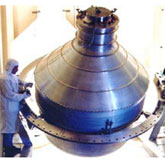
A Ring Around a Dying Star
In November 2002, sky watchers were viewing the glow of meteors from the Leonid meteor shower burning up in Earth's atmosphere. They had been anticipating this celestial light show for months, ... Continue reading
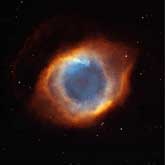
Neptune: The Basics
The eighth planet from the Sun, Neptune was the first planet located through mathematical predictions rather than through regular observations of the sky. When Uranus didn't travel exactly as ... Continue reading
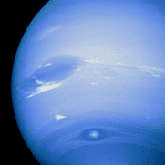
Backyard Telescopes for New Planets. Is it Possible?
Fifteen years ago, the largest telescopes in the world had yet to locate a planet orbiting another star. Today telescopes no larger than those available in department stores are proving capable of ... Continue reading
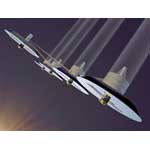
Sputnik and The Dawn of the Space Age
History changed on October 4, 1957, when the Soviet Union successfully launched Sputnik I. The world's first artificial satellite was about the size of a basketball, weighed only 183 pounds, and took ... Continue reading

Rossi X-ray Timing Explorer Solves Mystery of Pulsar 'Speed Limit'
Gravitational radiation, ripples in the fabric of space predicted by Albert Einstein, may serve as a cosmic traffic enforcer, protecting reckless pulsars from spinning too fast and blowing apart, ... Continue reading

Pluto Is Way Out There
Long considered to be the smallest, coldest, and most distant planet from the Sun, Pluto may also be the largest of a group of objects that orbit in a disk-like zone of beyond the orbit of Neptune ... Continue reading
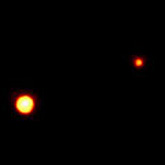
Venus Is Hot Stuff
At first glance, if Earth had a twin, it would be Venus. The two planets are similar in size, mass, composition, and distance from the Sun. But there the similarities end. Venus has no ocean. Venus is ... Continue reading
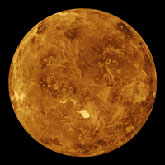
Saturn: The Basics
To ancient astronomers, Saturn was a wandering light near the edge of the known universe. The planet and its rings have been objects of beauty and wonder ever since Galileo noticed the 'cup handles' ... Continue reading
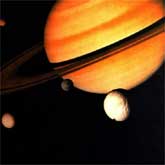
Space Lasers Keep Earth's Air Clean
Space laser technology is coming to our smokestacks and automobiles. Leave it to NASA to take its inventions to another level, helping to keep our air clean and breathable. A recent NASA invention, ... Continue reading
